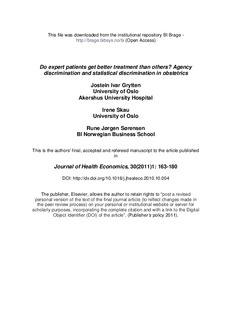| dc.contributor.author | Grytten, Jostein Ivar | |
| dc.contributor.author | Skau, Irene | |
| dc.contributor.author | Sørensen, Rune Jørgen | |
| dc.date.accessioned | 2012-09-12T08:59:07Z | |
| dc.date.available | 2012-09-12T08:59:07Z | |
| dc.date.issued | 2011 | |
| dc.identifier.citation | Journal of Health Economics, 30(2011)1: 163-180 | |
| dc.identifier.issn | 0167-6296 (e-utg) | |
| dc.identifier.uri | http://hdl.handle.net/11250/93654 | |
| dc.description | This is the authors’ final, accepted and refereed manuscript to the article | no_NO |
| dc.description.abstract | We address models that can explain why expert patients (obstetricians, midwives and doctors) are treated better than non-experts (mainly non-medical training). Models of statistical discrimination show that benevolent doctors treat expert patients better, since experts are better at communicating with the doctor. Agency theory suggests that doctors have an incentive to limit hospital costs by distorting information to non-expert patients, but not to expert patients.
The hypotheses were tested on a large set of data, which contained information about the highest education of the parents, and detailed medical information about all births in Norway during the period 1967 to 2005 (Medical Birth Registry). The empirical analyses show that expert parents have a higher rate of Caesarean section than non-expert parents. The educational disparities were considerable 40 years ago, but have become markedly less over time. The analyses provide support for statistical discrimination theory, though agency theory cannot be totally excluded. | no_NO |
| dc.language.iso | eng | no_NO |
| dc.publisher | Elsevier | no_NO |
| dc.subject | statistical discrimination | no_NO |
| dc.subject | agency theory | no_NO |
| dc.subject | Caesarean section | no_NO |
| dc.subject | expert patients | no_NO |
| dc.subject | disparities | no_NO |
| dc.title | Do expert patients get better treatment than others? Agency discrimination and statistical discrimination in obstetrics | no_NO |
| dc.type | Journal article | no_NO |
| dc.type | Peer reviewed | no_NO |
| dc.source.pagenumber | 163-180 | no_NO |
| dc.source.volume | 30 | no_NO |
| dc.source.journal | Journal of Health Economics | no_NO |
| dc.source.issue | 1 | no_NO |
| dc.identifier.doi | http://dx.doi.org/10.1016/j.jhealeco.2010.10.004 | |
